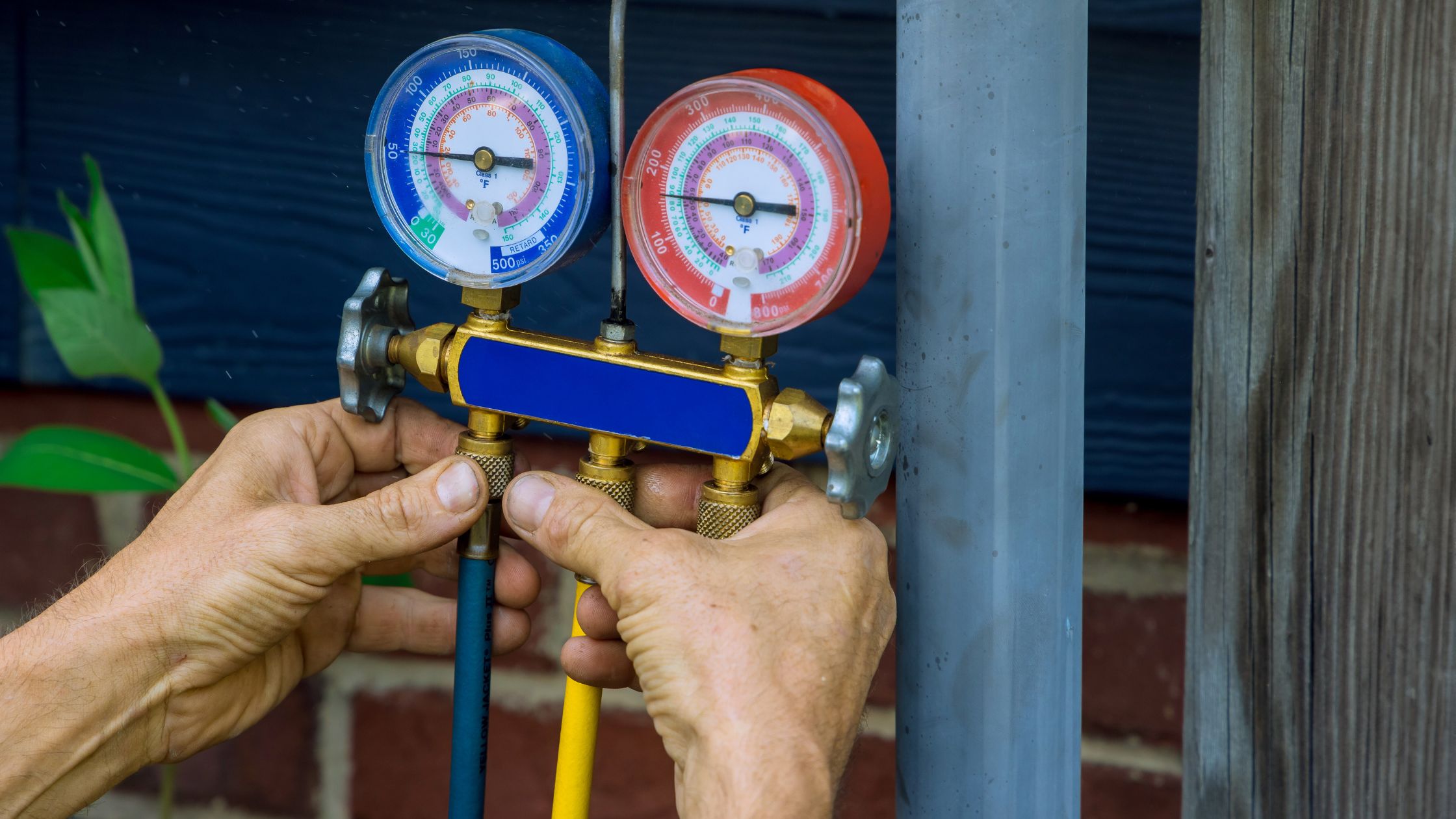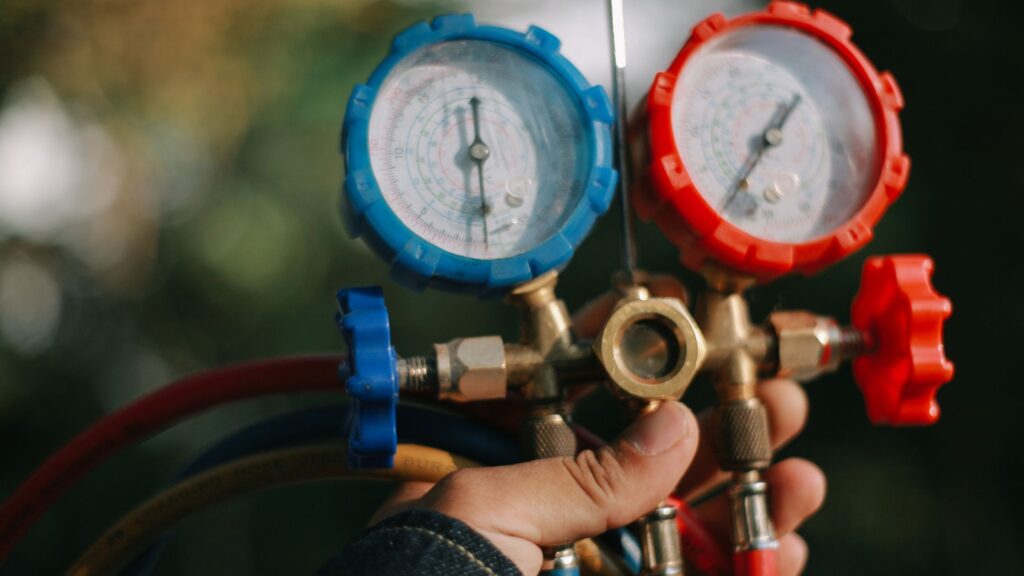R-454B Refrigerant: A Step Toward Sustainability

As the global climate crisis intensifies, industries around the world are rethinking their environmental impact—including the HVAC sector. Refrigerants, though essential for cooling and heating systems, have long contributed to greenhouse gas emissions due to their high Global Warming Potential (GWP). For years, R-410A was the industry standard, offering reliable performance but with a significant environmental cost.

Now, a new generation of refrigerants is emerging to help address these concerns, and leading the charge is R-454B Refrigerant. Engineered to significantly reduce GWP while maintaining the performance HVAC professionals and consumers expect, R-454B is quickly gaining recognition as a more sustainable alternative. It represents a critical step toward meeting global climate goals and regulatory requirements—without compromising on comfort or efficiency.
In this blog, we’ll explore what makes R-454B unique, why it’s replacing R-410A, and how its adoption is shaping the future of environmentally responsible HVAC solutions.
What Is R-454B?
R-454B is a next-generation refrigerant specifically developed as a more environmentally friendly replacement for R-410A in air conditioning and heat pump systems. It is a hydrofluoroolefin (HFO) blend, primarily composed of R-32 and R-1234yf, and is classified as an A2L refrigerant—meaning it is mildly flammable but considered low in toxicity.
With a Global Warming Potential (GWP) of just 466, R-454B offers a substantial reduction—nearly 80%—compared to R-410A’s GWP of approximately 2,088. This makes it a strong candidate for helping HVAC manufacturers and building owners meet increasingly stringent environmental regulations.
R-454B is engineered to deliver similar system performance, pressure levels, and energy efficiency as R-410A. This compatibility allows HVAC equipment manufacturers to make a relatively smooth transition with only minor design adjustments. For end-users, it provides a sustainable solution without sacrificing reliability, comfort, or cost-effectiveness.
As one of the most promising low-GWP refrigerants currently on the market, R-454B is setting a new standard for climate-conscious HVAC design.
Why the Shift From R-410A to R-454B?
For many years, R-410A has been the go-to refrigerant in residential and commercial HVAC systems due to its stability, efficiency, and widespread availability. However, its high Global Warming Potential (GWP) of approximately 2,088 has become a growing concern in light of escalating climate challenges and new environmental regulations.
In response, global efforts like the Kigali Amendment to the Montreal Protocol and national policies such as the U.S. EPA’s SNAP (Significant New Alternatives Policy) program are pushing for the phasedown of high-GWP hydrofluorocarbons (HFCs) like R-410A. These initiatives aim to transition the industry toward lower-impact alternatives that reduce greenhouse gas emissions and align with broader climate goals.
This is where R-454B comes in. With a GWP of just 466, R-454B reduces the environmental footprint of HVAC systems by nearly 80% compared to R-410A—without sacrificing performance. It offers a viable, long-term solution for manufacturers and contractors looking to stay ahead of regulatory changes and meet sustainability targets.
Additionally, R-454B is being widely adopted by major HVAC brands—including Carrier, Trane, and Johnson Controls—as the replacement of choice for new equipment. This growing industry momentum is accelerating the shift, ensuring R-454B will soon become the new standard in environmentally responsible cooling and heating.
Benefits of R-454B Refrigerant
The transition to R-454B isn’t just about meeting environmental regulations—it’s about delivering a better, more sustainable future for the HVAC industry and its consumers. Here are some of the key benefits that make R-454B a compelling choice:
1. Dramatically Lower Global Warming Potential (GWP)
R-454B has a GWP of just 466, which is nearly 80% lower than R-410A. This significant reduction makes it one of the lowest-GWP alternatives currently approved for use in comfort cooling applications, helping businesses and homeowners reduce their carbon footprint.
2. High Performance and Energy Efficiency
Despite its lower environmental impact, R-454B delivers comparable or improved energy efficiency compared to R-410A. Systems using R-454B can maintain optimal cooling and heating performance while potentially lowering energy consumption over time.
3. Compatibility with Modern HVAC Equipment
R-454B is designed to work with next-generation systems from major HVAC manufacturers. Many of these systems require minimal modifications from R-410A designs, making the transition smoother for contractors and equipment manufacturers alike.
4. Supported by Industry Leaders
Industry giants like Carrier, Trane, and Johnson Controls have already committed to R-454B as their preferred refrigerant for new product lines. This widespread support means long-term availability, serviceability, and manufacturer training will be readily accessible.
5. Future-Proof for Environmental Compliance
By making the switch to R-454B, contractors and property owners are future-proofing their systems against tightening regulations. It’s a proactive step toward meeting upcoming efficiency and emissions standards without needing another major refrigerant change in the near future.
R-454B combines performance, sustainability, and forward-thinking design—making it a strong choice for both the environment and everyday HVAC needs.
Safety Considerations
While R-454B offers numerous environmental and performance benefits, it’s important to understand the safety protocols associated with its use. As an A2L refrigerant, R-454B is classified as mildly flammable and low in toxicity by ASHRAE (American Society of Heating, Refrigerating and Air-Conditioning Engineers). This classification marks a shift from R-410A, which was non-flammable (A1), and requires updated handling procedures.
1. Understanding A2L Classification
The A2L rating means that while R-454B has a low flammability risk under normal operating conditions, proper precautions must still be taken. The refrigerant will not ignite easily, but in the event of a leak in a confined space with an ignition source, it could pose a hazard. That’s why regulatory bodies and equipment manufacturers are emphasizing training and safety updates.
2. Updated Standards and Guidelines
To ensure safe adoption, organizations such as UL (Underwriters Laboratories) and ASHRAE have released revised safety standards, including:
- UL 60335-2-40: Updated for equipment using A2L refrigerants
- ASHRAE 15 and 34: Address safe use, charge limits, and leak detection requirements
Manufacturers are designing equipment with these standards in mind, incorporating features like leak detection sensors and proper ventilation controls.
3. Technician Training and Certification
Contractors and HVAC technicians must undergo specific training for A2L refrigerants. This includes:
- Safe handling and transportation
- Leak detection and repair best practices
- Emergency response and ventilation strategies
Many HVAC associations and OEMs now offer certification courses to prepare professionals for safe installation and servicing of R-454B systems.
4. Storage and Transportation
R-454B should be stored in well-ventilated areas, away from heat sources or open flames. Though it is more stable than higher-flammability refrigerants, it should still be transported and stored in accordance with local regulations and Material Safety Data Sheet (MSDS) guidelines.
While the shift to A2L refrigerants introduces new safety considerations, R-454B can be safely handled with proper training and updated practices, ensuring a smooth and responsible transition for the HVAC industry.
Industry Adoption & Availability
As environmental regulations tighten and demand grows for climate-friendly solutions, R-454B is rapidly gaining traction across the HVAC industry. Its balance of performance, safety, and low Global Warming Potential (GWP) has positioned it as a preferred choice for leading manufacturers and industry stakeholders.
1. Early Adoption by Major HVAC Brands
Several top HVAC companies have already committed to adopting R-454B as the long-term replacement for R-410A. Industry leaders such as:
- Carrier (with its Puron Advance line),
- Trane Technologies, and
- Johnson Controls (York)
have announced product lines specifically engineered to run on R-454B.
These manufacturers are driving the market forward by integrating R-454B into new residential and light commercial systems, ensuring that installers and end-users have access to reliable, future-ready options.
2. Global and Regional Market Rollout
R-454B’s adoption is being accelerated by global policy changes, especially in regions like:
- North America (guided by the U.S. AIM Act and EPA SNAP rulings),
- Europe (under the EU F-Gas Regulation),
- Asia-Pacific, where urban centers are pushing for greener infrastructure.
As a result, R-454B is already available in many regional markets, and its presence is expected to grow significantly over the next few years as R-410A is phased down.
3. Equipment Compatibility and Supply Chain Readiness
To support the transition, OEMs are releasing R-454B-ready systems along with compatible components like compressors, expansion valves, and recovery equipment. Distributors are also expanding inventory to ensure availability of refrigerant cylinders, tools, and training materials needed for safe installation and servicing.
Contractors and technicians are encouraged to begin preparing now, as supply chains are aligning to support the wide-scale use of R-454B systems by 2025 and beyond.
4. Support from Industry Associations
Organizations like AHRI (Air-Conditioning, Heating, and Refrigeration Institute) and ACCA (Air Conditioning Contractors of America) are actively promoting R-454B through educational resources, webinars, and guidance documents—making it easier for professionals to stay informed and up to date.
In short, R-454B is not just a future option—it’s today’s reality for environmentally responsible HVAC. Its growing adoption ensures that both consumers and contractors can make confident, regulation-ready choices without waiting for tomorrow’s technology.
What This Means for Contractors & Consumers
The shift to R-454B refrigerant is more than a technical update—it represents a fundamental change in how HVAC systems are designed, installed, and maintained. Both contractors and consumers stand to benefit from this transition, but it’s important to understand what’s changing and how to prepare.
For Contractors: Get Ready for the New Standard
Training and Certification:
R-454B is classified as an A2L (mildly flammable) refrigerant, so technicians must complete updated training on safe handling, leak detection, and system servicing. Many manufacturers and trade associations are already offering certification programs to support this.
Tools and Equipment:
While many existing tools will remain usable, some specialized gauges, recovery units, and leak detectors may be required. Investing in the right tools now will help contractors stay ahead of the curve.
Customer Education:
HVAC professionals will play a key role in educating clients about the benefits of R-454B systems, including energy savings, regulatory compliance, and environmental impact. Being able to clearly communicate these points will build trust and position contractors as sustainability-minded experts.
Business Opportunities:
As homeowners and businesses upgrade to R-454B-compatible systems, contractors will see new opportunities for installations, retrofits, and maintenance services. Early adopters who embrace this change can gain a competitive edge.
For Consumers: Cleaner, Smarter Cooling
Environmental Responsibility:
Choosing an HVAC system with R-454B means making a conscious choice to reduce your carbon footprint. With up to 80% lower GWP than R-410A, R-454B contributes to a healthier planet without compromising comfort.
Long-Term Compliance:
New environmental regulations will increasingly restrict the use of high-GWP refrigerants. By investing in R-454B technology now, consumers ensure their systems are future-proof and aligned with upcoming standards.
Energy Efficiency and Cost Savings:
R-454B-powered systems offer comparable or improved energy efficiency, which can translate to lower utility bills over time—especially when combined with modern HVAC system features like smart thermostats and variable-speed compressors.
Increased Home Value:
Eco-friendly upgrades are becoming more attractive in the real estate market. An R-454B HVAC system may contribute to higher home resale value and appeal to sustainability-conscious buyers.
As the industry moves toward greener practices, R-454B represents a smart, sustainable choice for both contractors and consumers. Embracing it today ensures you’re prepared for the regulatory landscape of tomorrow—while delivering better performance and peace of mind.
The Future of Refrigerants and Sustainability
The HVAC industry stands at a turning point—driven by the urgent need to reduce greenhouse gas emissions and adopt more sustainable technologies. R-454B is a critical step in this journey, but it also signals a broader shift toward a future where efficiency, safety, and environmental responsibility go hand in hand.
1. Aligning with Global Climate Goals
Efforts like the Kigali Amendment, the Paris Agreement, and national climate policies are pushing for a significant reduction in the use of high-GWP refrigerants. R-454B supports these goals by offering a low-GWP alternative that’s commercially viable and already in use. As adoption expands, its impact on global emissions reduction will grow significantly.
2. Bridging the Gap to the Next Generation
While R-454B is a major improvement over R-410A, research continues into ultra-low-GWP and natural refrigerants like CO₂ (R-744), ammonia (R-717), and hydrocarbon-based options. These alternatives may play larger roles in the future, especially in commercial or industrial applications, but R-454B serves as a reliable bridge that balances sustainability with scalability for today’s residential and light commercial markets.
3. Encouraging Innovation Across the Industry
The move to R-454B is not just about switching refrigerants—it’s encouraging innovative HVAC system designs that are more efficient, smarter, and better suited to evolving building codes and energy standards. This includes improved compressors, leak detection systems, and digital controls that maximize performance and safety.
4. Supporting Green Building Initiatives
As green building certifications like LEED, WELL, and ENERGY STAR become more popular, refrigerants with low environmental impact are becoming essential. R-454B contributes to meeting the criteria for these programs, making it an attractive option for developers, facility managers, and eco-conscious homeowners.
5. A Shared Responsibility
Ultimately, creating a sustainable HVAC future requires cooperation across the entire value chain—from manufacturers and contractors to policymakers and consumers. R-454B is proof that the industry can innovate in ways that are practical, efficient, and environmentally sound.
The future of refrigerants is already unfolding, and R-454B marks a significant milestone in that evolution—helping build a cleaner, more sustainable world, one cooling system at a time.
R-454B with TSC Air
As the HVAC industry embraces a greener future, R-454B stands out as a smart and sustainable solution that balances environmental responsibility with reliable performance. With its dramatically lower Global Warming Potential, compatibility with modern systems, and growing support from industry leaders, R-454B is paving the way toward a cleaner, climate-conscious standard for comfort cooling.
Whether you’re an HVAC contractor preparing for the next phase of refrigerant regulations or a homeowner looking to invest in a future-ready system, R-454B offers a practical path forward. Making the switch today means aligning with tomorrow’s environmental standards—while enjoying the energy efficiency and peace of mind that come with innovation backed by trusted brands.
At TSC Air, we’re committed to helping you make informed, future-forward HVAC choices. Our certified experts are ready to guide you through the benefits of R-454B and connect you with high-performance, environmentally responsible systems tailored to your needs.
Ready to take the next step? Visit TSC Air to explore R-454B-compatible solutions and schedule a consultation with our team.
Cool smarter. Breathe easier. Choose R-454B with TSC Air.
